Saline Nasal Irrigation for Allergic Rhinitis: A Critical Review
VerifiedAdded on 2023/06/04
|18
|4554
|310
Literature Review
AI Summary
This literature review critically examines the evidence surrounding the use of saline nasal irrigation, particularly hypertonic solutions, for the treatment of allergic rhinitis. It begins by highlighting the uncertainty in the current evidence base and justifying the selection of this topic due to the lack of systematic reviews. The review then summarizes the current use of evidence-based practice in the Australian healthcare setting, noting the common use of antihistamines and saline sprays. A synthesis and analysis of six key articles, along with supporting literature, compares and contrasts the findings regarding the efficacy of hypertonic versus normal saline solutions, considering study designs, populations, and outcomes such as nasal clearance time, symptom relief, and quality of life. The review addresses the conflicting findings and limitations of studies, including heterogeneity of information and potential adverse effects, and concludes by discussing the rationale for decision-making in the context of the identified uncertainties, ultimately aiming to inform safe, acceptable, and cost-effective treatment options.
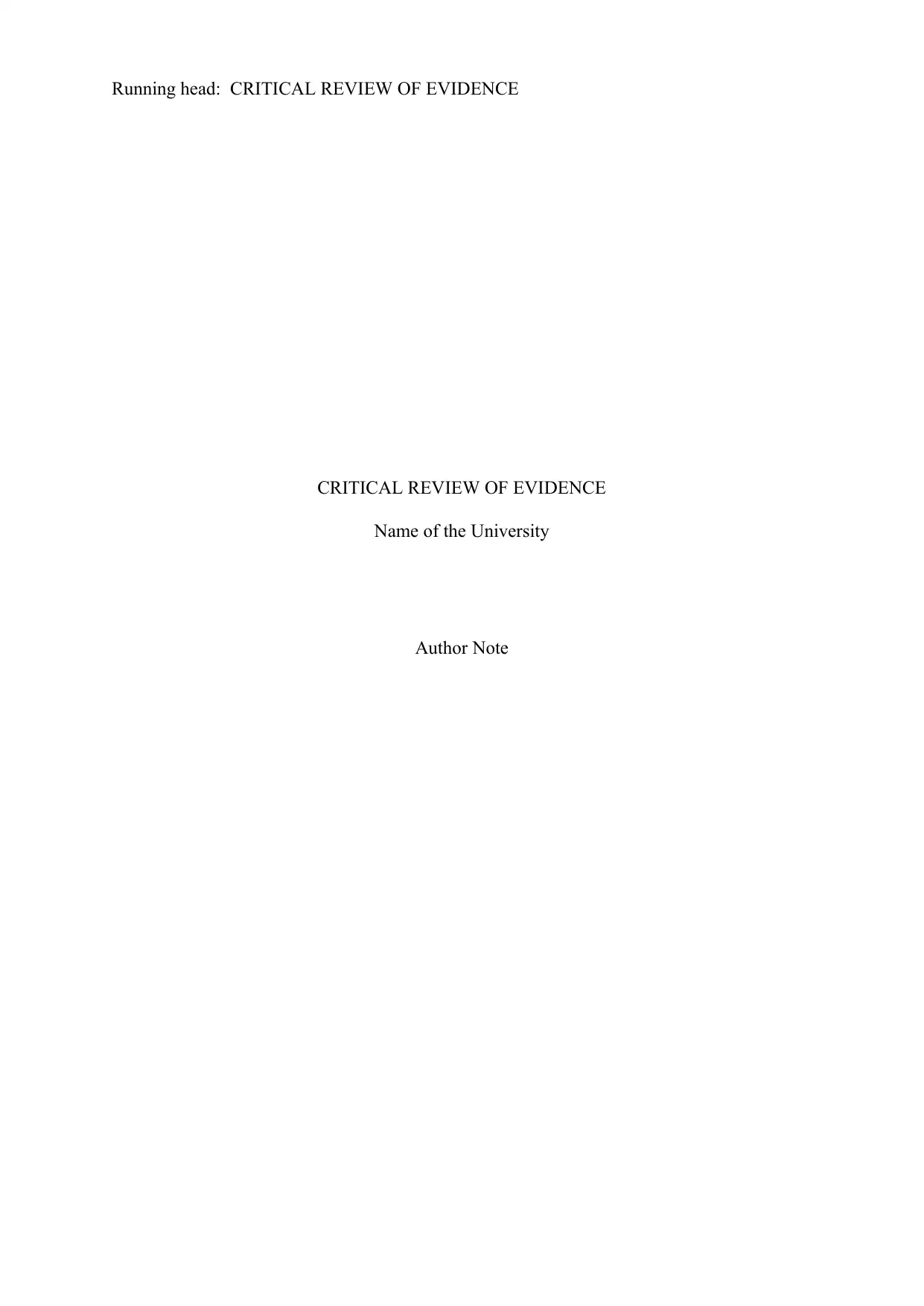
Running head: CRITICAL REVIEW OF EVIDENCE
CRITICAL REVIEW OF EVIDENCE
Name of the University
Author Note
CRITICAL REVIEW OF EVIDENCE
Name of the University
Author Note
Paraphrase This Document
Need a fresh take? Get an instant paraphrase of this document with our AI Paraphraser
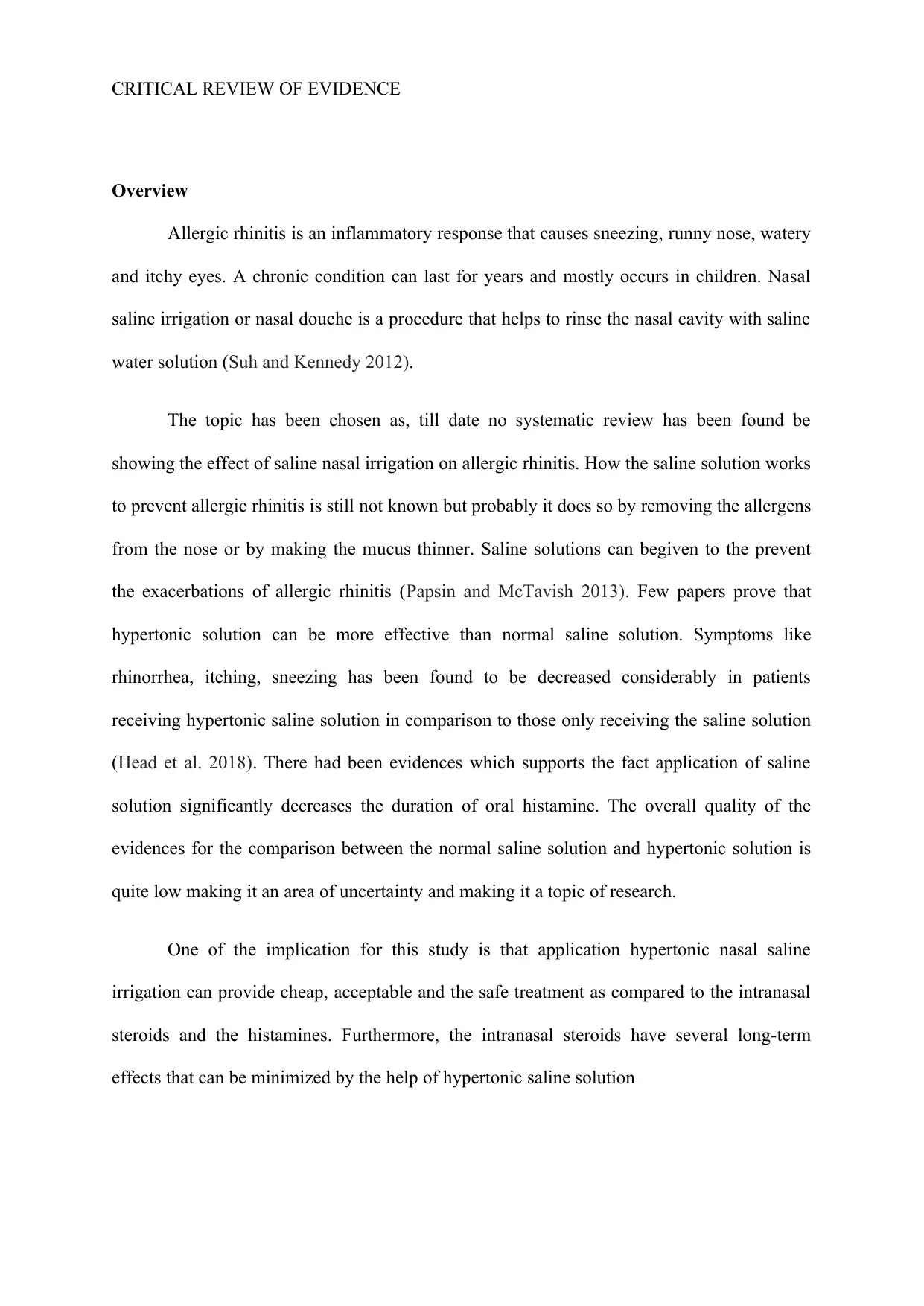
CRITICAL REVIEW OF EVIDENCE
Overview
Allergic rhinitis is an inflammatory response that causes sneezing, runny nose, watery
and itchy eyes. A chronic condition can last for years and mostly occurs in children. Nasal
saline irrigation or nasal douche is a procedure that helps to rinse the nasal cavity with saline
water solution (Suh and Kennedy 2012).
The topic has been chosen as, till date no systematic review has been found be
showing the effect of saline nasal irrigation on allergic rhinitis. How the saline solution works
to prevent allergic rhinitis is still not known but probably it does so by removing the allergens
from the nose or by making the mucus thinner. Saline solutions can begiven to the prevent
the exacerbations of allergic rhinitis (Papsin and McTavish 2013). Few papers prove that
hypertonic solution can be more effective than normal saline solution. Symptoms like
rhinorrhea, itching, sneezing has been found to be decreased considerably in patients
receiving hypertonic saline solution in comparison to those only receiving the saline solution
(Head et al. 2018). There had been evidences which supports the fact application of saline
solution significantly decreases the duration of oral histamine. The overall quality of the
evidences for the comparison between the normal saline solution and hypertonic solution is
quite low making it an area of uncertainty and making it a topic of research.
One of the implication for this study is that application hypertonic nasal saline
irrigation can provide cheap, acceptable and the safe treatment as compared to the intranasal
steroids and the histamines. Furthermore, the intranasal steroids have several long-term
effects that can be minimized by the help of hypertonic saline solution
Overview
Allergic rhinitis is an inflammatory response that causes sneezing, runny nose, watery
and itchy eyes. A chronic condition can last for years and mostly occurs in children. Nasal
saline irrigation or nasal douche is a procedure that helps to rinse the nasal cavity with saline
water solution (Suh and Kennedy 2012).
The topic has been chosen as, till date no systematic review has been found be
showing the effect of saline nasal irrigation on allergic rhinitis. How the saline solution works
to prevent allergic rhinitis is still not known but probably it does so by removing the allergens
from the nose or by making the mucus thinner. Saline solutions can begiven to the prevent
the exacerbations of allergic rhinitis (Papsin and McTavish 2013). Few papers prove that
hypertonic solution can be more effective than normal saline solution. Symptoms like
rhinorrhea, itching, sneezing has been found to be decreased considerably in patients
receiving hypertonic saline solution in comparison to those only receiving the saline solution
(Head et al. 2018). There had been evidences which supports the fact application of saline
solution significantly decreases the duration of oral histamine. The overall quality of the
evidences for the comparison between the normal saline solution and hypertonic solution is
quite low making it an area of uncertainty and making it a topic of research.
One of the implication for this study is that application hypertonic nasal saline
irrigation can provide cheap, acceptable and the safe treatment as compared to the intranasal
steroids and the histamines. Furthermore, the intranasal steroids have several long-term
effects that can be minimized by the help of hypertonic saline solution
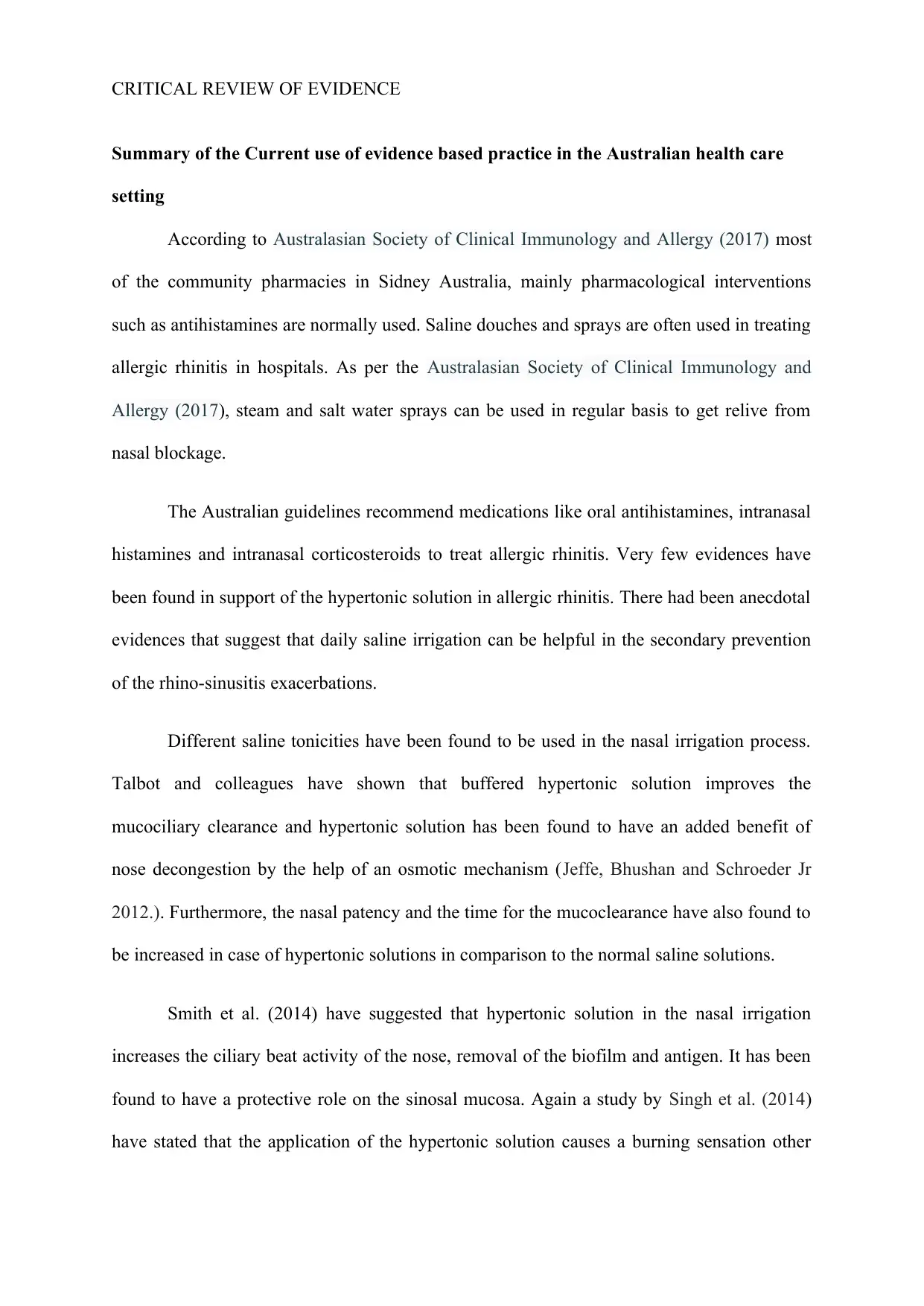
CRITICAL REVIEW OF EVIDENCE
Summary of the Current use of evidence based practice in the Australian health care
setting
According to Australasian Society of Clinical Immunology and Allergy (2017) most
of the community pharmacies in Sidney Australia, mainly pharmacological interventions
such as antihistamines are normally used. Saline douches and sprays are often used in treating
allergic rhinitis in hospitals. As per the Australasian Society of Clinical Immunology and
Allergy (2017), steam and salt water sprays can be used in regular basis to get relive from
nasal blockage.
The Australian guidelines recommend medications like oral antihistamines, intranasal
histamines and intranasal corticosteroids to treat allergic rhinitis. Very few evidences have
been found in support of the hypertonic solution in allergic rhinitis. There had been anecdotal
evidences that suggest that daily saline irrigation can be helpful in the secondary prevention
of the rhino-sinusitis exacerbations.
Different saline tonicities have been found to be used in the nasal irrigation process.
Talbot and colleagues have shown that buffered hypertonic solution improves the
mucociliary clearance and hypertonic solution has been found to have an added benefit of
nose decongestion by the help of an osmotic mechanism (Jeffe, Bhushan and Schroeder Jr
2012.). Furthermore, the nasal patency and the time for the mucoclearance have also found to
be increased in case of hypertonic solutions in comparison to the normal saline solutions.
Smith et al. (2014) have suggested that hypertonic solution in the nasal irrigation
increases the ciliary beat activity of the nose, removal of the biofilm and antigen. It has been
found to have a protective role on the sinosal mucosa. Again a study by Singh et al. (2014)
have stated that the application of the hypertonic solution causes a burning sensation other
Summary of the Current use of evidence based practice in the Australian health care
setting
According to Australasian Society of Clinical Immunology and Allergy (2017) most
of the community pharmacies in Sidney Australia, mainly pharmacological interventions
such as antihistamines are normally used. Saline douches and sprays are often used in treating
allergic rhinitis in hospitals. As per the Australasian Society of Clinical Immunology and
Allergy (2017), steam and salt water sprays can be used in regular basis to get relive from
nasal blockage.
The Australian guidelines recommend medications like oral antihistamines, intranasal
histamines and intranasal corticosteroids to treat allergic rhinitis. Very few evidences have
been found in support of the hypertonic solution in allergic rhinitis. There had been anecdotal
evidences that suggest that daily saline irrigation can be helpful in the secondary prevention
of the rhino-sinusitis exacerbations.
Different saline tonicities have been found to be used in the nasal irrigation process.
Talbot and colleagues have shown that buffered hypertonic solution improves the
mucociliary clearance and hypertonic solution has been found to have an added benefit of
nose decongestion by the help of an osmotic mechanism (Jeffe, Bhushan and Schroeder Jr
2012.). Furthermore, the nasal patency and the time for the mucoclearance have also found to
be increased in case of hypertonic solutions in comparison to the normal saline solutions.
Smith et al. (2014) have suggested that hypertonic solution in the nasal irrigation
increases the ciliary beat activity of the nose, removal of the biofilm and antigen. It has been
found to have a protective role on the sinosal mucosa. Again a study by Singh et al. (2014)
have stated that the application of the hypertonic solution causes a burning sensation other
⊘ This is a preview!⊘
Do you want full access?
Subscribe today to unlock all pages.

Trusted by 1+ million students worldwide
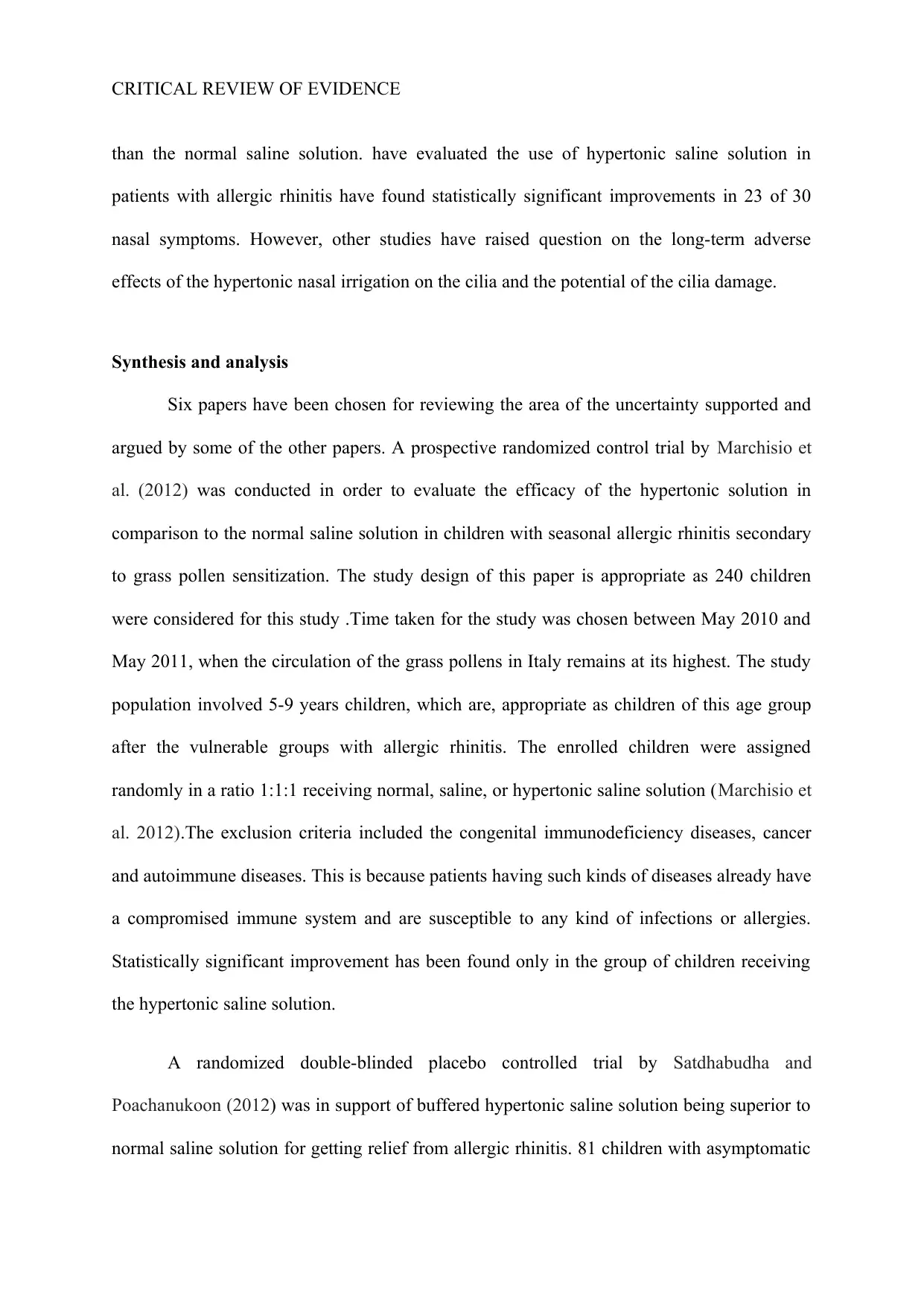
CRITICAL REVIEW OF EVIDENCE
than the normal saline solution. have evaluated the use of hypertonic saline solution in
patients with allergic rhinitis have found statistically significant improvements in 23 of 30
nasal symptoms. However, other studies have raised question on the long-term adverse
effects of the hypertonic nasal irrigation on the cilia and the potential of the cilia damage.
Synthesis and analysis
Six papers have been chosen for reviewing the area of the uncertainty supported and
argued by some of the other papers. A prospective randomized control trial by Marchisio et
al. (2012) was conducted in order to evaluate the efficacy of the hypertonic solution in
comparison to the normal saline solution in children with seasonal allergic rhinitis secondary
to grass pollen sensitization. The study design of this paper is appropriate as 240 children
were considered for this study .Time taken for the study was chosen between May 2010 and
May 2011, when the circulation of the grass pollens in Italy remains at its highest. The study
population involved 5-9 years children, which are, appropriate as children of this age group
after the vulnerable groups with allergic rhinitis. The enrolled children were assigned
randomly in a ratio 1:1:1 receiving normal, saline, or hypertonic saline solution (Marchisio et
al. 2012).The exclusion criteria included the congenital immunodeficiency diseases, cancer
and autoimmune diseases. This is because patients having such kinds of diseases already have
a compromised immune system and are susceptible to any kind of infections or allergies.
Statistically significant improvement has been found only in the group of children receiving
the hypertonic saline solution.
A randomized double-blinded placebo controlled trial by Satdhabudha and
Poachanukoon (2012) was in support of buffered hypertonic saline solution being superior to
normal saline solution for getting relief from allergic rhinitis. 81 children with asymptomatic
than the normal saline solution. have evaluated the use of hypertonic saline solution in
patients with allergic rhinitis have found statistically significant improvements in 23 of 30
nasal symptoms. However, other studies have raised question on the long-term adverse
effects of the hypertonic nasal irrigation on the cilia and the potential of the cilia damage.
Synthesis and analysis
Six papers have been chosen for reviewing the area of the uncertainty supported and
argued by some of the other papers. A prospective randomized control trial by Marchisio et
al. (2012) was conducted in order to evaluate the efficacy of the hypertonic solution in
comparison to the normal saline solution in children with seasonal allergic rhinitis secondary
to grass pollen sensitization. The study design of this paper is appropriate as 240 children
were considered for this study .Time taken for the study was chosen between May 2010 and
May 2011, when the circulation of the grass pollens in Italy remains at its highest. The study
population involved 5-9 years children, which are, appropriate as children of this age group
after the vulnerable groups with allergic rhinitis. The enrolled children were assigned
randomly in a ratio 1:1:1 receiving normal, saline, or hypertonic saline solution (Marchisio et
al. 2012).The exclusion criteria included the congenital immunodeficiency diseases, cancer
and autoimmune diseases. This is because patients having such kinds of diseases already have
a compromised immune system and are susceptible to any kind of infections or allergies.
Statistically significant improvement has been found only in the group of children receiving
the hypertonic saline solution.
A randomized double-blinded placebo controlled trial by Satdhabudha and
Poachanukoon (2012) was in support of buffered hypertonic saline solution being superior to
normal saline solution for getting relief from allergic rhinitis. 81 children with asymptomatic
Paraphrase This Document
Need a fresh take? Get an instant paraphrase of this document with our AI Paraphraser
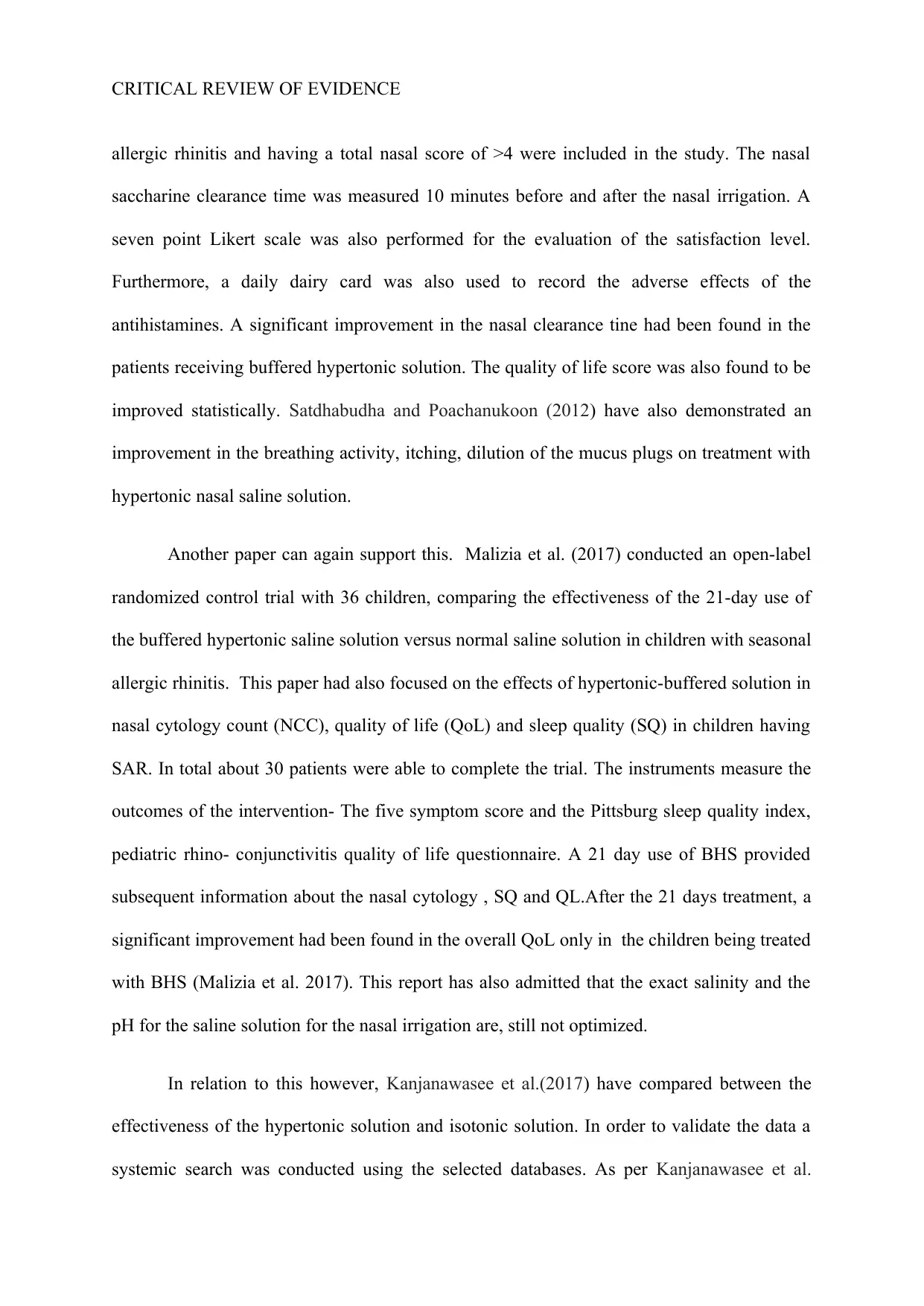
CRITICAL REVIEW OF EVIDENCE
allergic rhinitis and having a total nasal score of >4 were included in the study. The nasal
saccharine clearance time was measured 10 minutes before and after the nasal irrigation. A
seven point Likert scale was also performed for the evaluation of the satisfaction level.
Furthermore, a daily dairy card was also used to record the adverse effects of the
antihistamines. A significant improvement in the nasal clearance tine had been found in the
patients receiving buffered hypertonic solution. The quality of life score was also found to be
improved statistically. Satdhabudha and Poachanukoon (2012) have also demonstrated an
improvement in the breathing activity, itching, dilution of the mucus plugs on treatment with
hypertonic nasal saline solution.
Another paper can again support this. Malizia et al. (2017) conducted an open-label
randomized control trial with 36 children, comparing the effectiveness of the 21-day use of
the buffered hypertonic saline solution versus normal saline solution in children with seasonal
allergic rhinitis. This paper had also focused on the effects of hypertonic-buffered solution in
nasal cytology count (NCC), quality of life (QoL) and sleep quality (SQ) in children having
SAR. In total about 30 patients were able to complete the trial. The instruments measure the
outcomes of the intervention- The five symptom score and the Pittsburg sleep quality index,
pediatric rhino- conjunctivitis quality of life questionnaire. A 21 day use of BHS provided
subsequent information about the nasal cytology , SQ and QL.After the 21 days treatment, a
significant improvement had been found in the overall QoL only in the children being treated
with BHS (Malizia et al. 2017). This report has also admitted that the exact salinity and the
pH for the saline solution for the nasal irrigation are, still not optimized.
In relation to this however, Kanjanawasee et al.(2017) have compared between the
effectiveness of the hypertonic solution and isotonic solution. In order to validate the data a
systemic search was conducted using the selected databases. As per Kanjanawasee et al.
allergic rhinitis and having a total nasal score of >4 were included in the study. The nasal
saccharine clearance time was measured 10 minutes before and after the nasal irrigation. A
seven point Likert scale was also performed for the evaluation of the satisfaction level.
Furthermore, a daily dairy card was also used to record the adverse effects of the
antihistamines. A significant improvement in the nasal clearance tine had been found in the
patients receiving buffered hypertonic solution. The quality of life score was also found to be
improved statistically. Satdhabudha and Poachanukoon (2012) have also demonstrated an
improvement in the breathing activity, itching, dilution of the mucus plugs on treatment with
hypertonic nasal saline solution.
Another paper can again support this. Malizia et al. (2017) conducted an open-label
randomized control trial with 36 children, comparing the effectiveness of the 21-day use of
the buffered hypertonic saline solution versus normal saline solution in children with seasonal
allergic rhinitis. This paper had also focused on the effects of hypertonic-buffered solution in
nasal cytology count (NCC), quality of life (QoL) and sleep quality (SQ) in children having
SAR. In total about 30 patients were able to complete the trial. The instruments measure the
outcomes of the intervention- The five symptom score and the Pittsburg sleep quality index,
pediatric rhino- conjunctivitis quality of life questionnaire. A 21 day use of BHS provided
subsequent information about the nasal cytology , SQ and QL.After the 21 days treatment, a
significant improvement had been found in the overall QoL only in the children being treated
with BHS (Malizia et al. 2017). This report has also admitted that the exact salinity and the
pH for the saline solution for the nasal irrigation are, still not optimized.
In relation to this however, Kanjanawasee et al.(2017) have compared between the
effectiveness of the hypertonic solution and isotonic solution. In order to validate the data a
systemic search was conducted using the selected databases. As per Kanjanawasee et al.
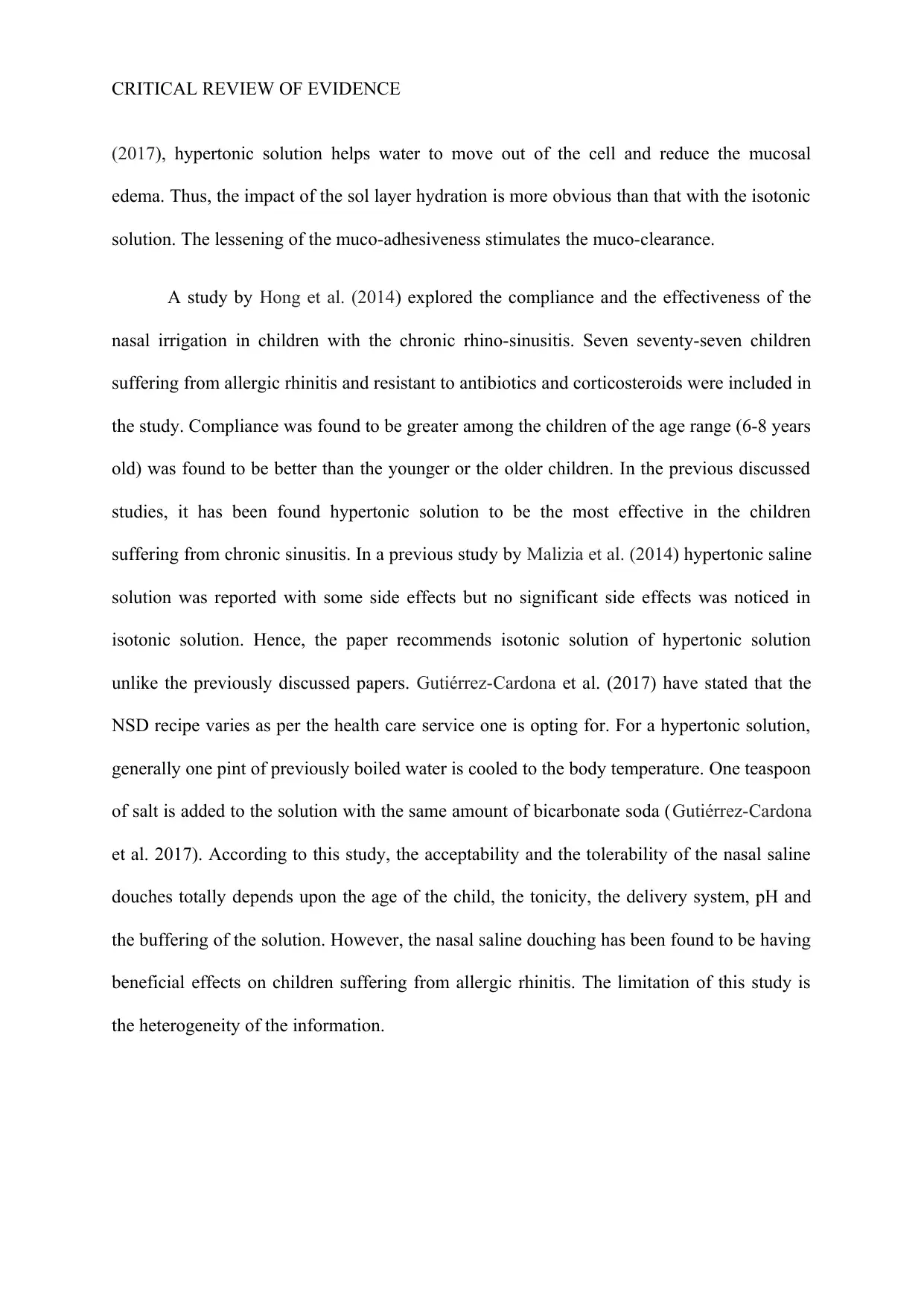
CRITICAL REVIEW OF EVIDENCE
(2017), hypertonic solution helps water to move out of the cell and reduce the mucosal
edema. Thus, the impact of the sol layer hydration is more obvious than that with the isotonic
solution. The lessening of the muco-adhesiveness stimulates the muco-clearance.
A study by Hong et al. (2014) explored the compliance and the effectiveness of the
nasal irrigation in children with the chronic rhino-sinusitis. Seven seventy-seven children
suffering from allergic rhinitis and resistant to antibiotics and corticosteroids were included in
the study. Compliance was found to be greater among the children of the age range (6-8 years
old) was found to be better than the younger or the older children. In the previous discussed
studies, it has been found hypertonic solution to be the most effective in the children
suffering from chronic sinusitis. In a previous study by Malizia et al. (2014) hypertonic saline
solution was reported with some side effects but no significant side effects was noticed in
isotonic solution. Hence, the paper recommends isotonic solution of hypertonic solution
unlike the previously discussed papers. Gutiérrez-Cardona et al. (2017) have stated that the
NSD recipe varies as per the health care service one is opting for. For a hypertonic solution,
generally one pint of previously boiled water is cooled to the body temperature. One teaspoon
of salt is added to the solution with the same amount of bicarbonate soda (Gutiérrez-Cardona
et al. 2017). According to this study, the acceptability and the tolerability of the nasal saline
douches totally depends upon the age of the child, the tonicity, the delivery system, pH and
the buffering of the solution. However, the nasal saline douching has been found to be having
beneficial effects on children suffering from allergic rhinitis. The limitation of this study is
the heterogeneity of the information.
(2017), hypertonic solution helps water to move out of the cell and reduce the mucosal
edema. Thus, the impact of the sol layer hydration is more obvious than that with the isotonic
solution. The lessening of the muco-adhesiveness stimulates the muco-clearance.
A study by Hong et al. (2014) explored the compliance and the effectiveness of the
nasal irrigation in children with the chronic rhino-sinusitis. Seven seventy-seven children
suffering from allergic rhinitis and resistant to antibiotics and corticosteroids were included in
the study. Compliance was found to be greater among the children of the age range (6-8 years
old) was found to be better than the younger or the older children. In the previous discussed
studies, it has been found hypertonic solution to be the most effective in the children
suffering from chronic sinusitis. In a previous study by Malizia et al. (2014) hypertonic saline
solution was reported with some side effects but no significant side effects was noticed in
isotonic solution. Hence, the paper recommends isotonic solution of hypertonic solution
unlike the previously discussed papers. Gutiérrez-Cardona et al. (2017) have stated that the
NSD recipe varies as per the health care service one is opting for. For a hypertonic solution,
generally one pint of previously boiled water is cooled to the body temperature. One teaspoon
of salt is added to the solution with the same amount of bicarbonate soda (Gutiérrez-Cardona
et al. 2017). According to this study, the acceptability and the tolerability of the nasal saline
douches totally depends upon the age of the child, the tonicity, the delivery system, pH and
the buffering of the solution. However, the nasal saline douching has been found to be having
beneficial effects on children suffering from allergic rhinitis. The limitation of this study is
the heterogeneity of the information.
⊘ This is a preview!⊘
Do you want full access?
Subscribe today to unlock all pages.

Trusted by 1+ million students worldwide
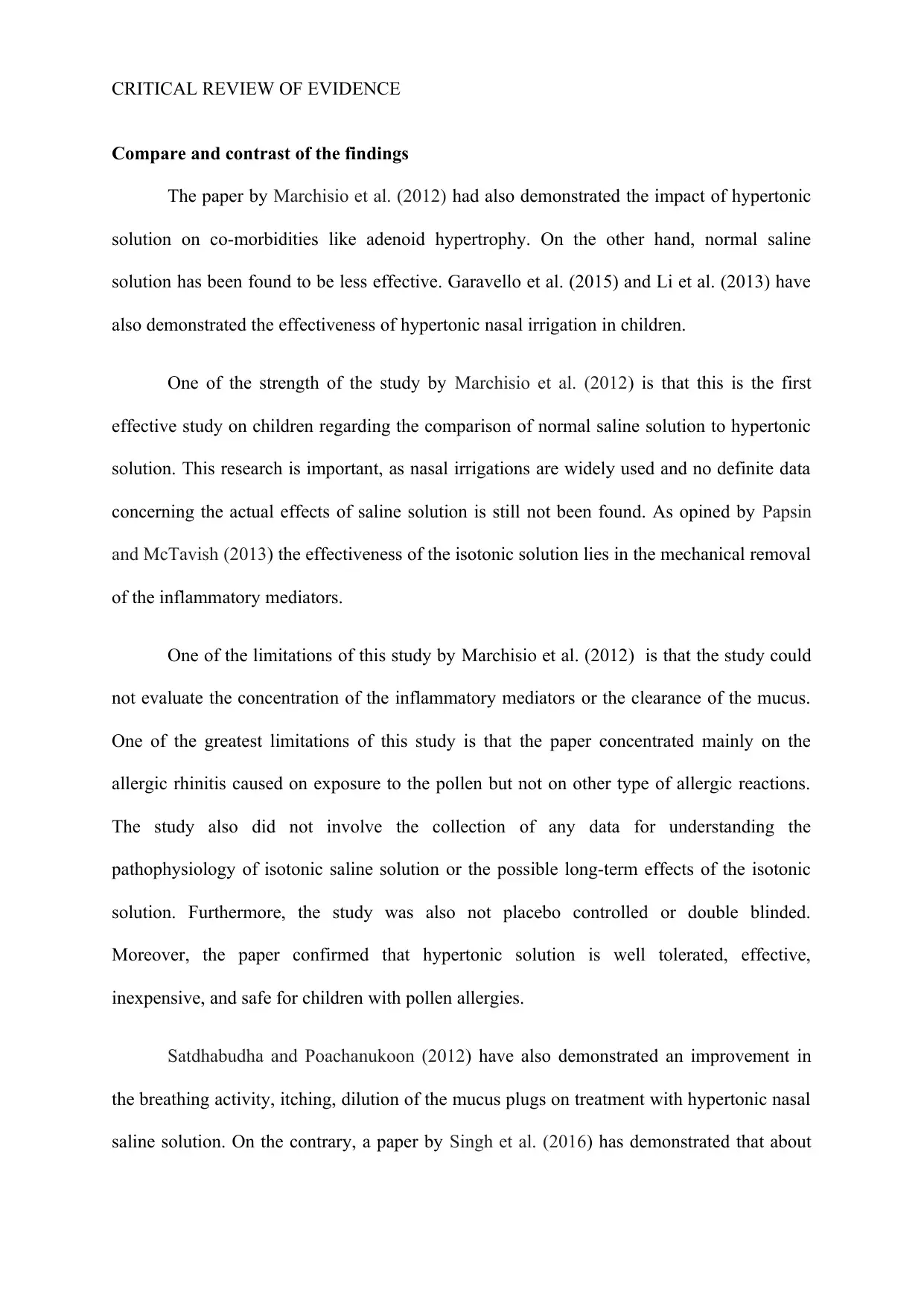
CRITICAL REVIEW OF EVIDENCE
Compare and contrast of the findings
The paper by Marchisio et al. (2012) had also demonstrated the impact of hypertonic
solution on co-morbidities like adenoid hypertrophy. On the other hand, normal saline
solution has been found to be less effective. Garavello et al. (2015) and Li et al. (2013) have
also demonstrated the effectiveness of hypertonic nasal irrigation in children.
One of the strength of the study by Marchisio et al. (2012) is that this is the first
effective study on children regarding the comparison of normal saline solution to hypertonic
solution. This research is important, as nasal irrigations are widely used and no definite data
concerning the actual effects of saline solution is still not been found. As opined by Papsin
and McTavish (2013) the effectiveness of the isotonic solution lies in the mechanical removal
of the inflammatory mediators.
One of the limitations of this study by Marchisio et al. (2012) is that the study could
not evaluate the concentration of the inflammatory mediators or the clearance of the mucus.
One of the greatest limitations of this study is that the paper concentrated mainly on the
allergic rhinitis caused on exposure to the pollen but not on other type of allergic reactions.
The study also did not involve the collection of any data for understanding the
pathophysiology of isotonic saline solution or the possible long-term effects of the isotonic
solution. Furthermore, the study was also not placebo controlled or double blinded.
Moreover, the paper confirmed that hypertonic solution is well tolerated, effective,
inexpensive, and safe for children with pollen allergies.
Satdhabudha and Poachanukoon (2012) have also demonstrated an improvement in
the breathing activity, itching, dilution of the mucus plugs on treatment with hypertonic nasal
saline solution. On the contrary, a paper by Singh et al. (2016) has demonstrated that about
Compare and contrast of the findings
The paper by Marchisio et al. (2012) had also demonstrated the impact of hypertonic
solution on co-morbidities like adenoid hypertrophy. On the other hand, normal saline
solution has been found to be less effective. Garavello et al. (2015) and Li et al. (2013) have
also demonstrated the effectiveness of hypertonic nasal irrigation in children.
One of the strength of the study by Marchisio et al. (2012) is that this is the first
effective study on children regarding the comparison of normal saline solution to hypertonic
solution. This research is important, as nasal irrigations are widely used and no definite data
concerning the actual effects of saline solution is still not been found. As opined by Papsin
and McTavish (2013) the effectiveness of the isotonic solution lies in the mechanical removal
of the inflammatory mediators.
One of the limitations of this study by Marchisio et al. (2012) is that the study could
not evaluate the concentration of the inflammatory mediators or the clearance of the mucus.
One of the greatest limitations of this study is that the paper concentrated mainly on the
allergic rhinitis caused on exposure to the pollen but not on other type of allergic reactions.
The study also did not involve the collection of any data for understanding the
pathophysiology of isotonic saline solution or the possible long-term effects of the isotonic
solution. Furthermore, the study was also not placebo controlled or double blinded.
Moreover, the paper confirmed that hypertonic solution is well tolerated, effective,
inexpensive, and safe for children with pollen allergies.
Satdhabudha and Poachanukoon (2012) have also demonstrated an improvement in
the breathing activity, itching, dilution of the mucus plugs on treatment with hypertonic nasal
saline solution. On the contrary, a paper by Singh et al. (2016) has demonstrated that about
Paraphrase This Document
Need a fresh take? Get an instant paraphrase of this document with our AI Paraphraser
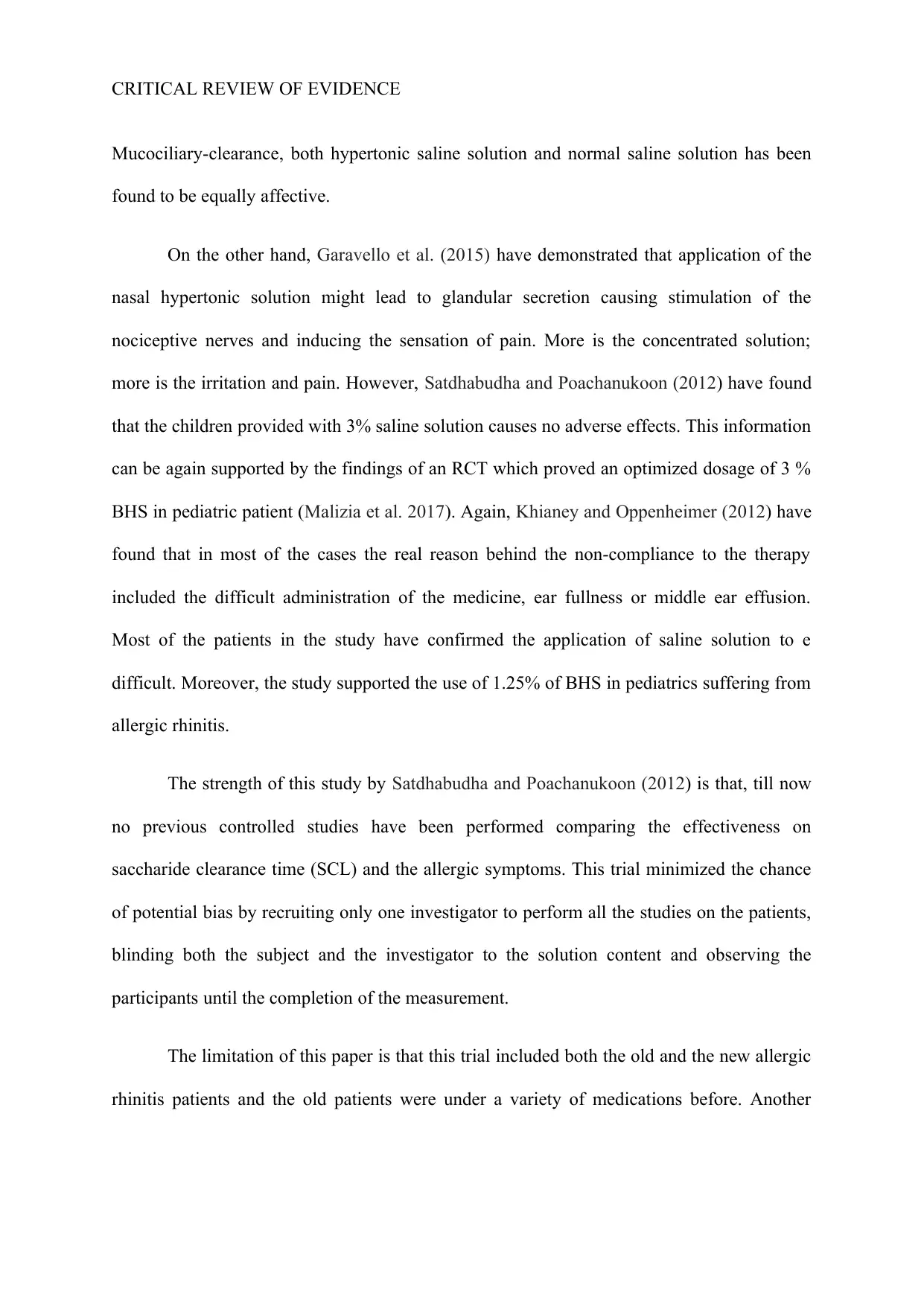
CRITICAL REVIEW OF EVIDENCE
Mucociliary-clearance, both hypertonic saline solution and normal saline solution has been
found to be equally affective.
On the other hand, Garavello et al. (2015) have demonstrated that application of the
nasal hypertonic solution might lead to glandular secretion causing stimulation of the
nociceptive nerves and inducing the sensation of pain. More is the concentrated solution;
more is the irritation and pain. However, Satdhabudha and Poachanukoon (2012) have found
that the children provided with 3% saline solution causes no adverse effects. This information
can be again supported by the findings of an RCT which proved an optimized dosage of 3 %
BHS in pediatric patient (Malizia et al. 2017). Again, Khianey and Oppenheimer (2012) have
found that in most of the cases the real reason behind the non-compliance to the therapy
included the difficult administration of the medicine, ear fullness or middle ear effusion.
Most of the patients in the study have confirmed the application of saline solution to e
difficult. Moreover, the study supported the use of 1.25% of BHS in pediatrics suffering from
allergic rhinitis.
The strength of this study by Satdhabudha and Poachanukoon (2012) is that, till now
no previous controlled studies have been performed comparing the effectiveness on
saccharide clearance time (SCL) and the allergic symptoms. This trial minimized the chance
of potential bias by recruiting only one investigator to perform all the studies on the patients,
blinding both the subject and the investigator to the solution content and observing the
participants until the completion of the measurement.
The limitation of this paper is that this trial included both the old and the new allergic
rhinitis patients and the old patients were under a variety of medications before. Another
Mucociliary-clearance, both hypertonic saline solution and normal saline solution has been
found to be equally affective.
On the other hand, Garavello et al. (2015) have demonstrated that application of the
nasal hypertonic solution might lead to glandular secretion causing stimulation of the
nociceptive nerves and inducing the sensation of pain. More is the concentrated solution;
more is the irritation and pain. However, Satdhabudha and Poachanukoon (2012) have found
that the children provided with 3% saline solution causes no adverse effects. This information
can be again supported by the findings of an RCT which proved an optimized dosage of 3 %
BHS in pediatric patient (Malizia et al. 2017). Again, Khianey and Oppenheimer (2012) have
found that in most of the cases the real reason behind the non-compliance to the therapy
included the difficult administration of the medicine, ear fullness or middle ear effusion.
Most of the patients in the study have confirmed the application of saline solution to e
difficult. Moreover, the study supported the use of 1.25% of BHS in pediatrics suffering from
allergic rhinitis.
The strength of this study by Satdhabudha and Poachanukoon (2012) is that, till now
no previous controlled studies have been performed comparing the effectiveness on
saccharide clearance time (SCL) and the allergic symptoms. This trial minimized the chance
of potential bias by recruiting only one investigator to perform all the studies on the patients,
blinding both the subject and the investigator to the solution content and observing the
participants until the completion of the measurement.
The limitation of this paper is that this trial included both the old and the new allergic
rhinitis patients and the old patients were under a variety of medications before. Another
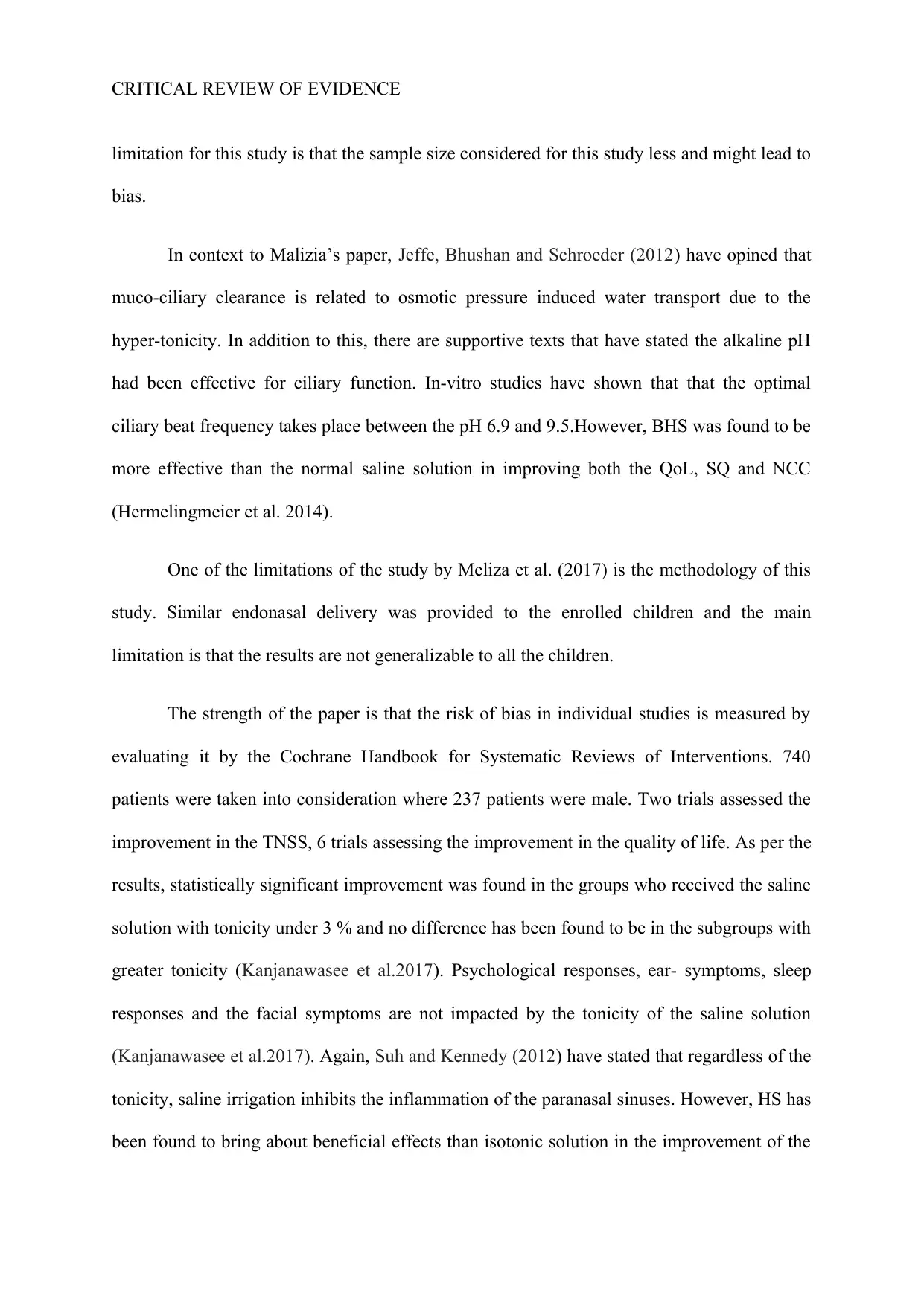
CRITICAL REVIEW OF EVIDENCE
limitation for this study is that the sample size considered for this study less and might lead to
bias.
In context to Malizia’s paper, Jeffe, Bhushan and Schroeder (2012) have opined that
muco-ciliary clearance is related to osmotic pressure induced water transport due to the
hyper-tonicity. In addition to this, there are supportive texts that have stated the alkaline pH
had been effective for ciliary function. In-vitro studies have shown that that the optimal
ciliary beat frequency takes place between the pH 6.9 and 9.5.However, BHS was found to be
more effective than the normal saline solution in improving both the QoL, SQ and NCC
(Hermelingmeier et al. 2014).
One of the limitations of the study by Meliza et al. (2017) is the methodology of this
study. Similar endonasal delivery was provided to the enrolled children and the main
limitation is that the results are not generalizable to all the children.
The strength of the paper is that the risk of bias in individual studies is measured by
evaluating it by the Cochrane Handbook for Systematic Reviews of Interventions. 740
patients were taken into consideration where 237 patients were male. Two trials assessed the
improvement in the TNSS, 6 trials assessing the improvement in the quality of life. As per the
results, statistically significant improvement was found in the groups who received the saline
solution with tonicity under 3 % and no difference has been found to be in the subgroups with
greater tonicity (Kanjanawasee et al.2017). Psychological responses, ear- symptoms, sleep
responses and the facial symptoms are not impacted by the tonicity of the saline solution
(Kanjanawasee et al.2017). Again, Suh and Kennedy (2012) have stated that regardless of the
tonicity, saline irrigation inhibits the inflammation of the paranasal sinuses. However, HS has
been found to bring about beneficial effects than isotonic solution in the improvement of the
limitation for this study is that the sample size considered for this study less and might lead to
bias.
In context to Malizia’s paper, Jeffe, Bhushan and Schroeder (2012) have opined that
muco-ciliary clearance is related to osmotic pressure induced water transport due to the
hyper-tonicity. In addition to this, there are supportive texts that have stated the alkaline pH
had been effective for ciliary function. In-vitro studies have shown that that the optimal
ciliary beat frequency takes place between the pH 6.9 and 9.5.However, BHS was found to be
more effective than the normal saline solution in improving both the QoL, SQ and NCC
(Hermelingmeier et al. 2014).
One of the limitations of the study by Meliza et al. (2017) is the methodology of this
study. Similar endonasal delivery was provided to the enrolled children and the main
limitation is that the results are not generalizable to all the children.
The strength of the paper is that the risk of bias in individual studies is measured by
evaluating it by the Cochrane Handbook for Systematic Reviews of Interventions. 740
patients were taken into consideration where 237 patients were male. Two trials assessed the
improvement in the TNSS, 6 trials assessing the improvement in the quality of life. As per the
results, statistically significant improvement was found in the groups who received the saline
solution with tonicity under 3 % and no difference has been found to be in the subgroups with
greater tonicity (Kanjanawasee et al.2017). Psychological responses, ear- symptoms, sleep
responses and the facial symptoms are not impacted by the tonicity of the saline solution
(Kanjanawasee et al.2017). Again, Suh and Kennedy (2012) have stated that regardless of the
tonicity, saline irrigation inhibits the inflammation of the paranasal sinuses. However, HS has
been found to bring about beneficial effects than isotonic solution in the improvement of the
⊘ This is a preview!⊘
Do you want full access?
Subscribe today to unlock all pages.

Trusted by 1+ million students worldwide
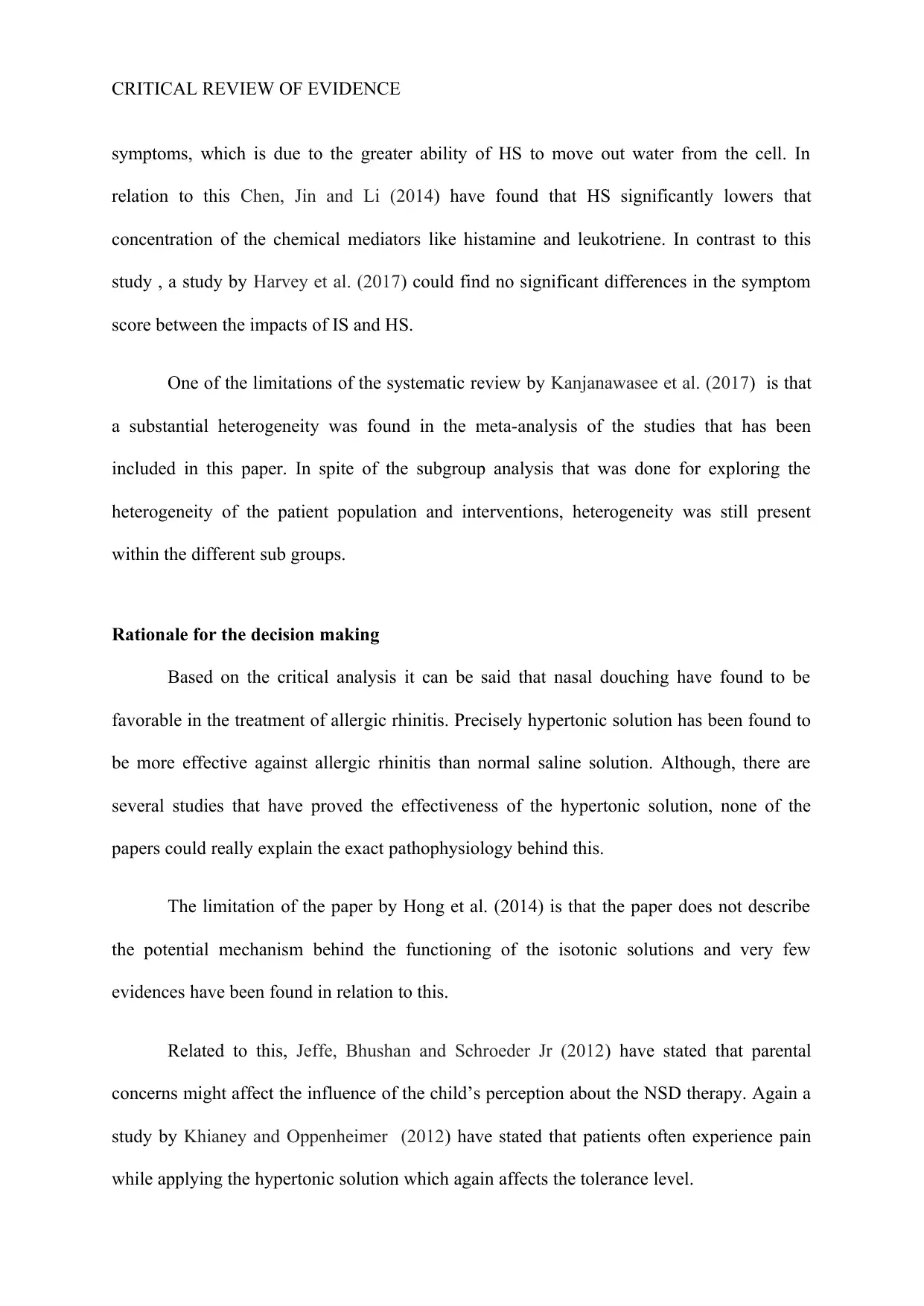
CRITICAL REVIEW OF EVIDENCE
symptoms, which is due to the greater ability of HS to move out water from the cell. In
relation to this Chen, Jin and Li (2014) have found that HS significantly lowers that
concentration of the chemical mediators like histamine and leukotriene. In contrast to this
study , a study by Harvey et al. (2017) could find no significant differences in the symptom
score between the impacts of IS and HS.
One of the limitations of the systematic review by Kanjanawasee et al. (2017) is that
a substantial heterogeneity was found in the meta-analysis of the studies that has been
included in this paper. In spite of the subgroup analysis that was done for exploring the
heterogeneity of the patient population and interventions, heterogeneity was still present
within the different sub groups.
Rationale for the decision making
Based on the critical analysis it can be said that nasal douching have found to be
favorable in the treatment of allergic rhinitis. Precisely hypertonic solution has been found to
be more effective against allergic rhinitis than normal saline solution. Although, there are
several studies that have proved the effectiveness of the hypertonic solution, none of the
papers could really explain the exact pathophysiology behind this.
The limitation of the paper by Hong et al. (2014) is that the paper does not describe
the potential mechanism behind the functioning of the isotonic solutions and very few
evidences have been found in relation to this.
Related to this, Jeffe, Bhushan and Schroeder Jr (2012) have stated that parental
concerns might affect the influence of the child’s perception about the NSD therapy. Again a
study by Khianey and Oppenheimer (2012) have stated that patients often experience pain
while applying the hypertonic solution which again affects the tolerance level.
symptoms, which is due to the greater ability of HS to move out water from the cell. In
relation to this Chen, Jin and Li (2014) have found that HS significantly lowers that
concentration of the chemical mediators like histamine and leukotriene. In contrast to this
study , a study by Harvey et al. (2017) could find no significant differences in the symptom
score between the impacts of IS and HS.
One of the limitations of the systematic review by Kanjanawasee et al. (2017) is that
a substantial heterogeneity was found in the meta-analysis of the studies that has been
included in this paper. In spite of the subgroup analysis that was done for exploring the
heterogeneity of the patient population and interventions, heterogeneity was still present
within the different sub groups.
Rationale for the decision making
Based on the critical analysis it can be said that nasal douching have found to be
favorable in the treatment of allergic rhinitis. Precisely hypertonic solution has been found to
be more effective against allergic rhinitis than normal saline solution. Although, there are
several studies that have proved the effectiveness of the hypertonic solution, none of the
papers could really explain the exact pathophysiology behind this.
The limitation of the paper by Hong et al. (2014) is that the paper does not describe
the potential mechanism behind the functioning of the isotonic solutions and very few
evidences have been found in relation to this.
Related to this, Jeffe, Bhushan and Schroeder Jr (2012) have stated that parental
concerns might affect the influence of the child’s perception about the NSD therapy. Again a
study by Khianey and Oppenheimer (2012) have stated that patients often experience pain
while applying the hypertonic solution which again affects the tolerance level.
Paraphrase This Document
Need a fresh take? Get an instant paraphrase of this document with our AI Paraphraser
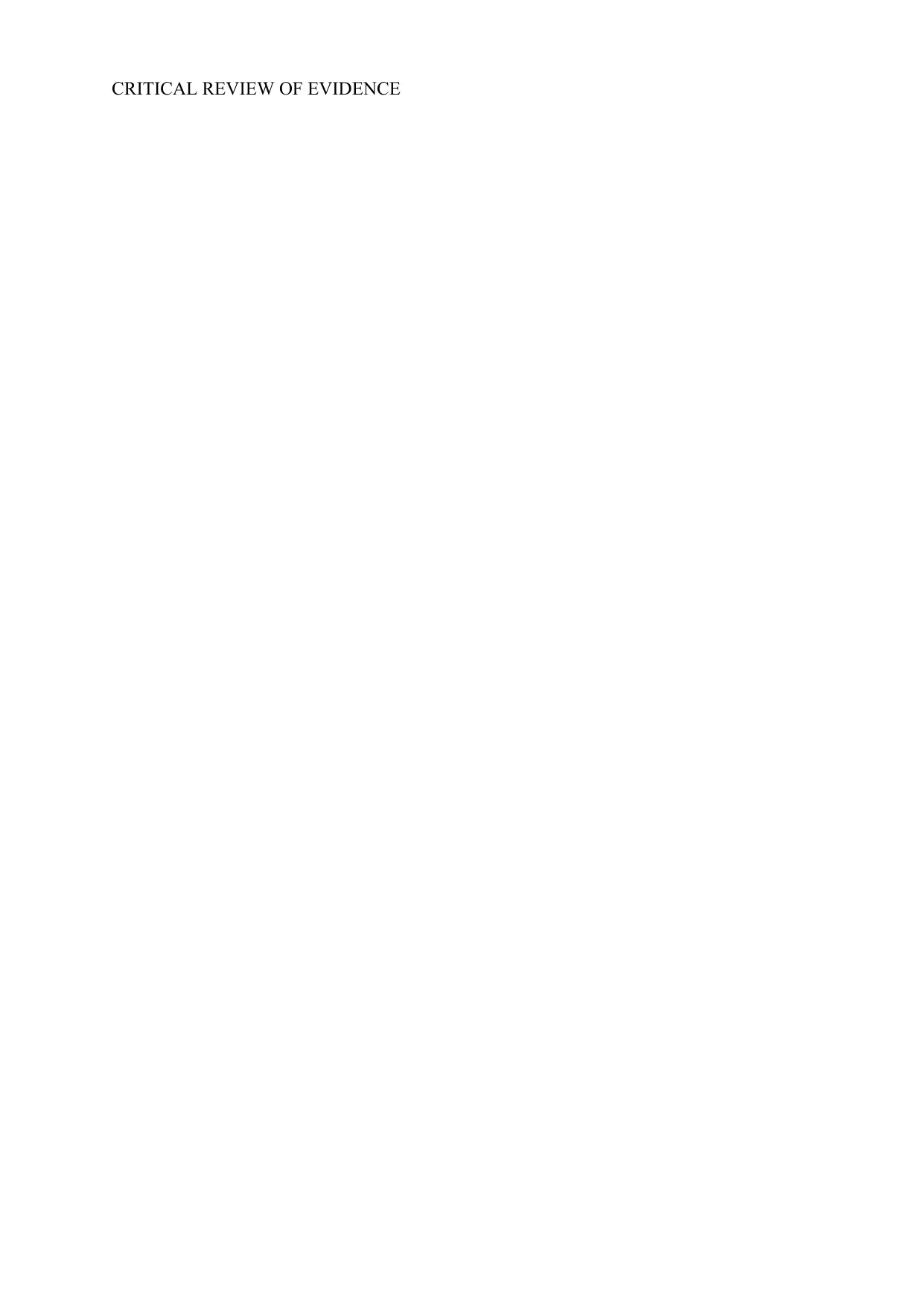
CRITICAL REVIEW OF EVIDENCE
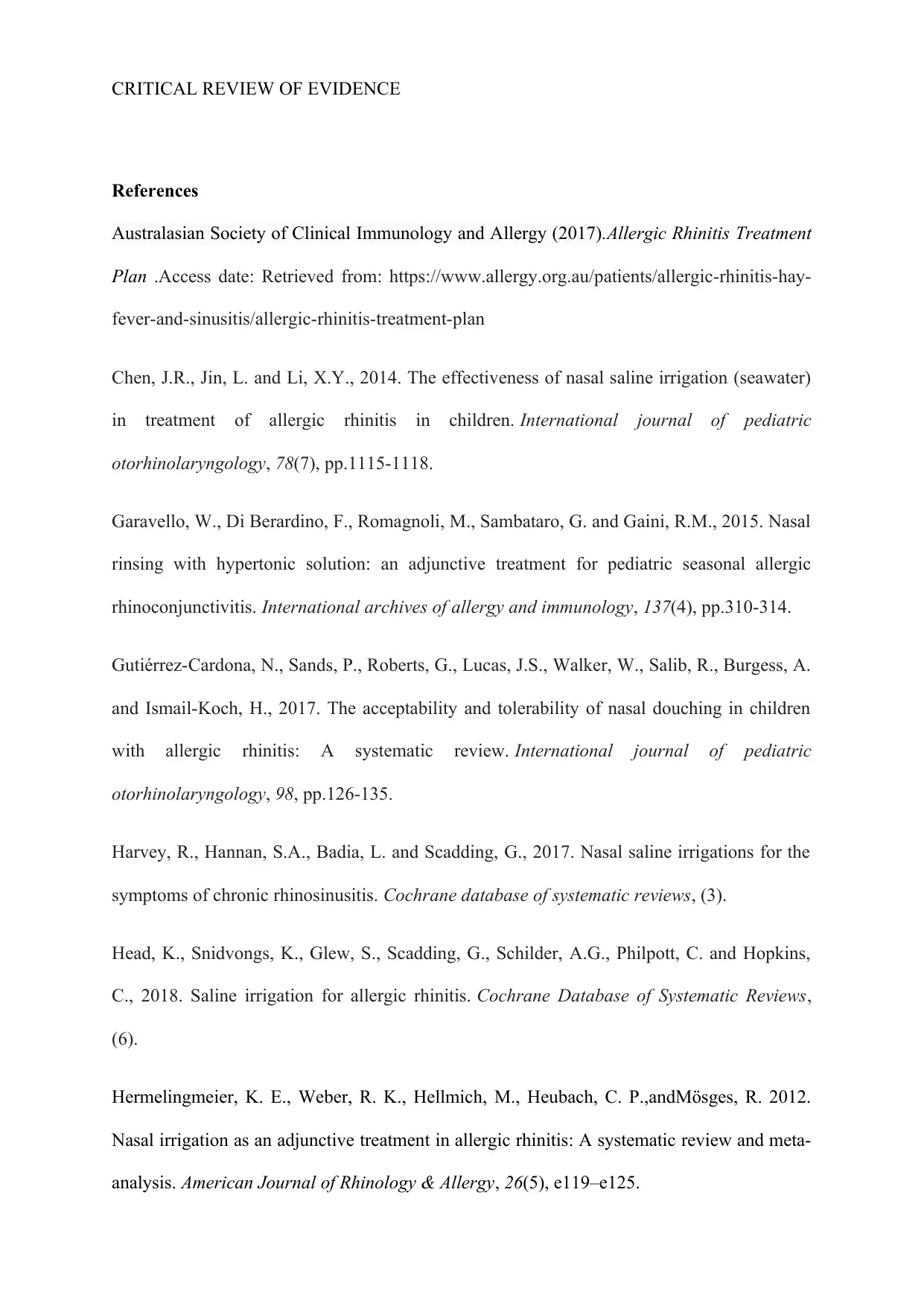
CRITICAL REVIEW OF EVIDENCE
References
Australasian Society of Clinical Immunology and Allergy (2017).Allergic Rhinitis Treatment
Plan .Access date: Retrieved from: https://www.allergy.org.au/patients/allergic-rhinitis-hay-
fever-and-sinusitis/allergic-rhinitis-treatment-plan
Chen, J.R., Jin, L. and Li, X.Y., 2014. The effectiveness of nasal saline irrigation (seawater)
in treatment of allergic rhinitis in children. International journal of pediatric
otorhinolaryngology, 78(7), pp.1115-1118.
Garavello, W., Di Berardino, F., Romagnoli, M., Sambataro, G. and Gaini, R.M., 2015. Nasal
rinsing with hypertonic solution: an adjunctive treatment for pediatric seasonal allergic
rhinoconjunctivitis. International archives of allergy and immunology, 137(4), pp.310-314.
Gutiérrez-Cardona, N., Sands, P., Roberts, G., Lucas, J.S., Walker, W., Salib, R., Burgess, A.
and Ismail-Koch, H., 2017. The acceptability and tolerability of nasal douching in children
with allergic rhinitis: A systematic review. International journal of pediatric
otorhinolaryngology, 98, pp.126-135.
Harvey, R., Hannan, S.A., Badia, L. and Scadding, G., 2017. Nasal saline irrigations for the
symptoms of chronic rhinosinusitis. Cochrane database of systematic reviews, (3).
Head, K., Snidvongs, K., Glew, S., Scadding, G., Schilder, A.G., Philpott, C. and Hopkins,
C., 2018. Saline irrigation for allergic rhinitis. Cochrane Database of Systematic Reviews,
(6).
Hermelingmeier, K. E., Weber, R. K., Hellmich, M., Heubach, C. P.,andMösges, R. 2012.
Nasal irrigation as an adjunctive treatment in allergic rhinitis: A systematic review and meta-
analysis. American Journal of Rhinology & Allergy, 26(5), e119–e125.
References
Australasian Society of Clinical Immunology and Allergy (2017).Allergic Rhinitis Treatment
Plan .Access date: Retrieved from: https://www.allergy.org.au/patients/allergic-rhinitis-hay-
fever-and-sinusitis/allergic-rhinitis-treatment-plan
Chen, J.R., Jin, L. and Li, X.Y., 2014. The effectiveness of nasal saline irrigation (seawater)
in treatment of allergic rhinitis in children. International journal of pediatric
otorhinolaryngology, 78(7), pp.1115-1118.
Garavello, W., Di Berardino, F., Romagnoli, M., Sambataro, G. and Gaini, R.M., 2015. Nasal
rinsing with hypertonic solution: an adjunctive treatment for pediatric seasonal allergic
rhinoconjunctivitis. International archives of allergy and immunology, 137(4), pp.310-314.
Gutiérrez-Cardona, N., Sands, P., Roberts, G., Lucas, J.S., Walker, W., Salib, R., Burgess, A.
and Ismail-Koch, H., 2017. The acceptability and tolerability of nasal douching in children
with allergic rhinitis: A systematic review. International journal of pediatric
otorhinolaryngology, 98, pp.126-135.
Harvey, R., Hannan, S.A., Badia, L. and Scadding, G., 2017. Nasal saline irrigations for the
symptoms of chronic rhinosinusitis. Cochrane database of systematic reviews, (3).
Head, K., Snidvongs, K., Glew, S., Scadding, G., Schilder, A.G., Philpott, C. and Hopkins,
C., 2018. Saline irrigation for allergic rhinitis. Cochrane Database of Systematic Reviews,
(6).
Hermelingmeier, K. E., Weber, R. K., Hellmich, M., Heubach, C. P.,andMösges, R. 2012.
Nasal irrigation as an adjunctive treatment in allergic rhinitis: A systematic review and meta-
analysis. American Journal of Rhinology & Allergy, 26(5), e119–e125.
⊘ This is a preview!⊘
Do you want full access?
Subscribe today to unlock all pages.

Trusted by 1+ million students worldwide
1 out of 18
Your All-in-One AI-Powered Toolkit for Academic Success.
+13062052269
info@desklib.com
Available 24*7 on WhatsApp / Email
![[object Object]](/_next/static/media/star-bottom.7253800d.svg)
Unlock your academic potential
Copyright © 2020–2025 A2Z Services. All Rights Reserved. Developed and managed by ZUCOL.

